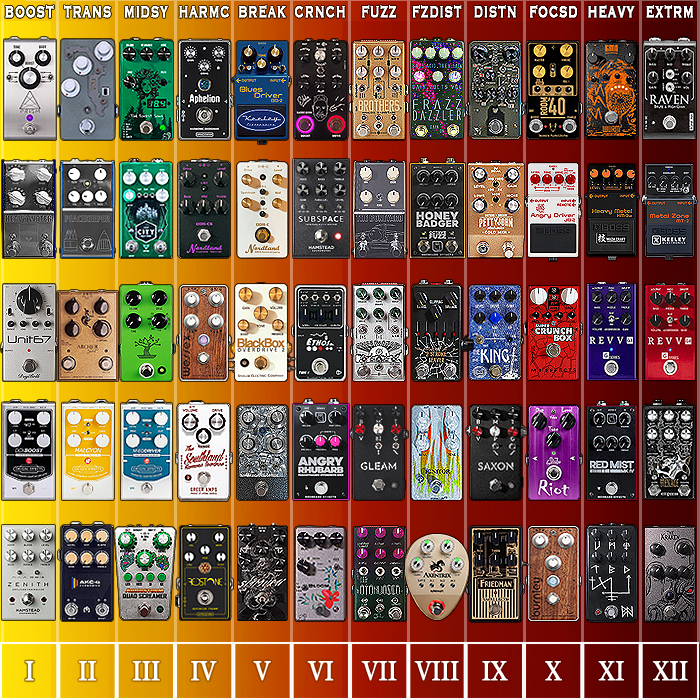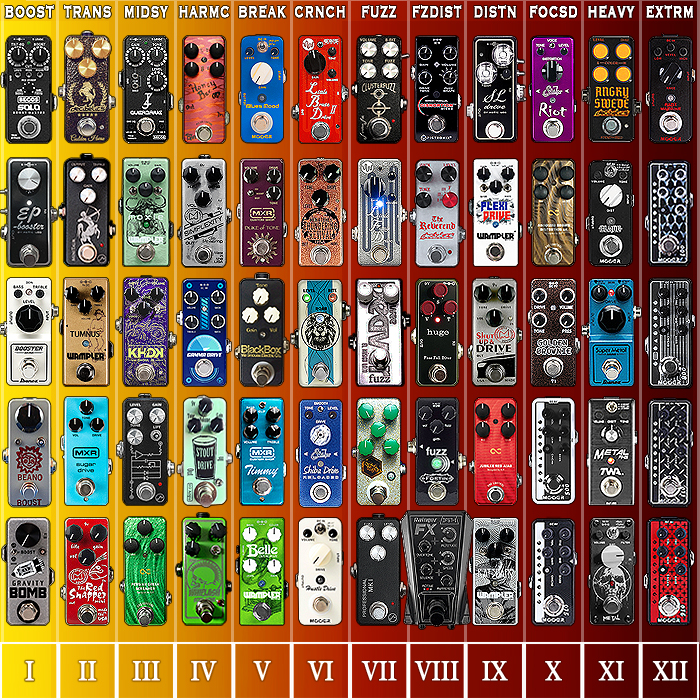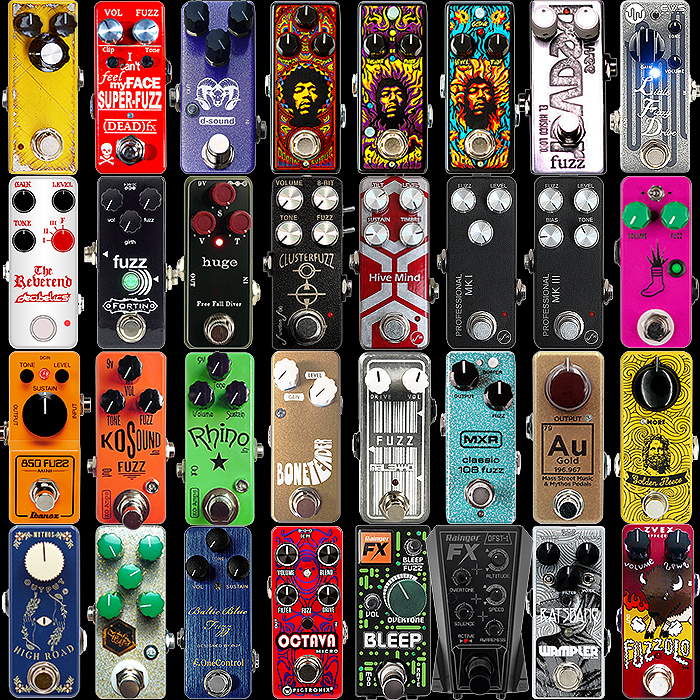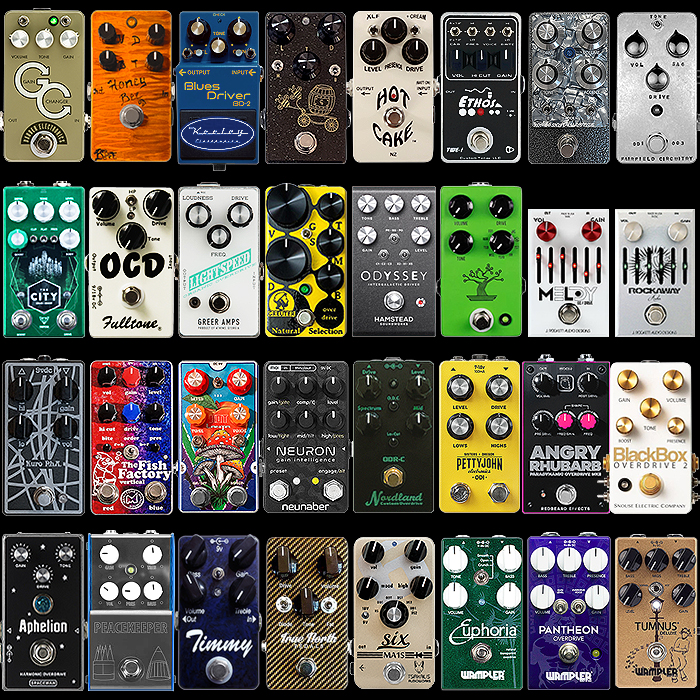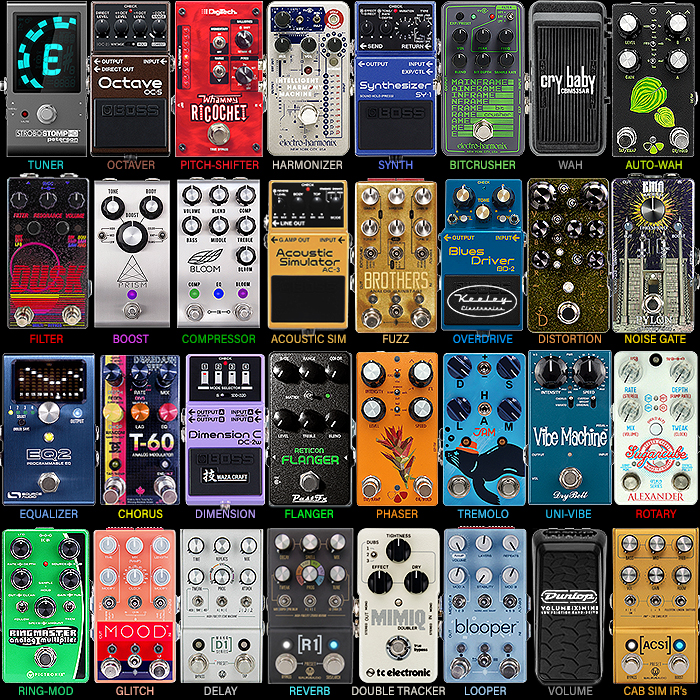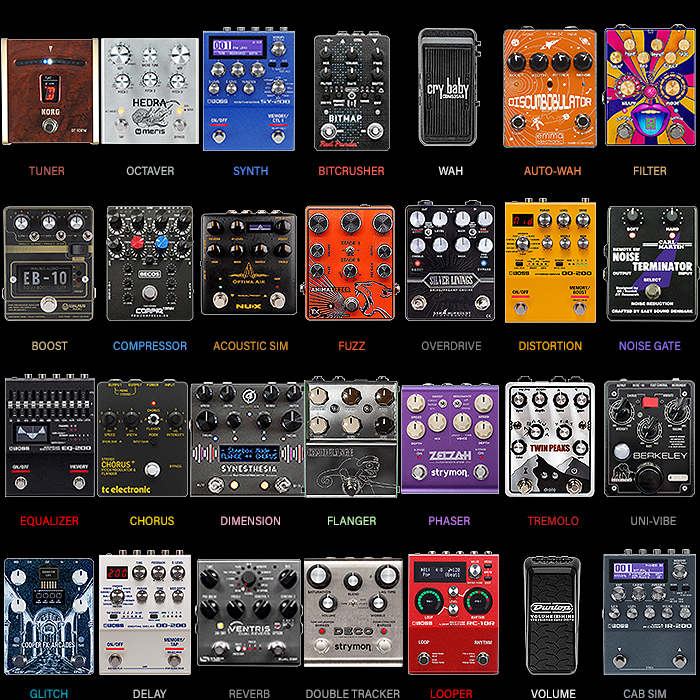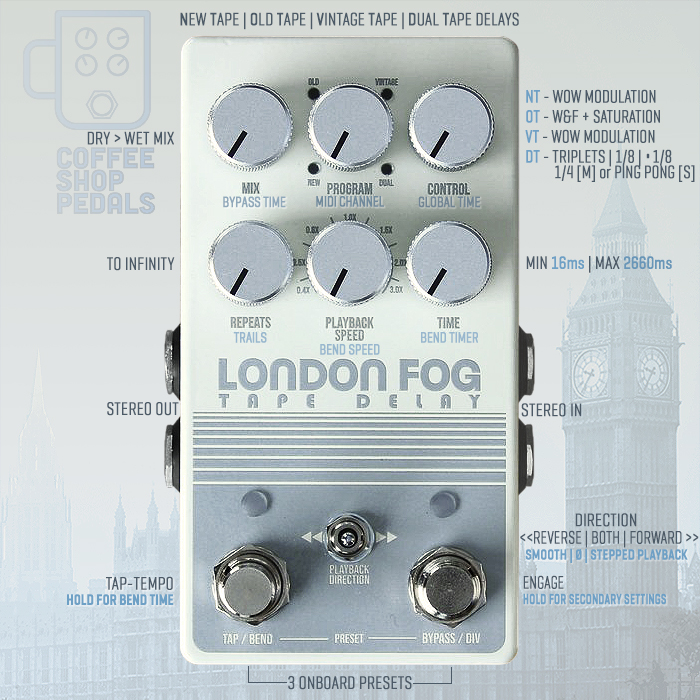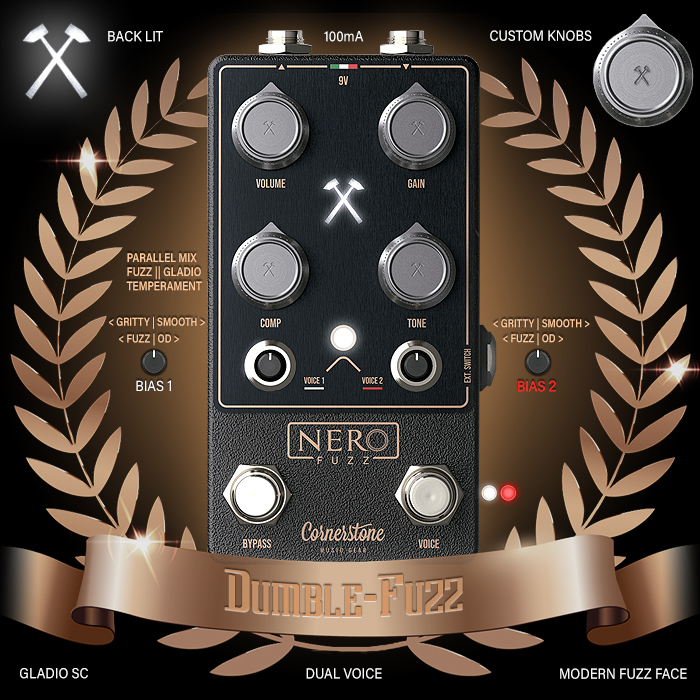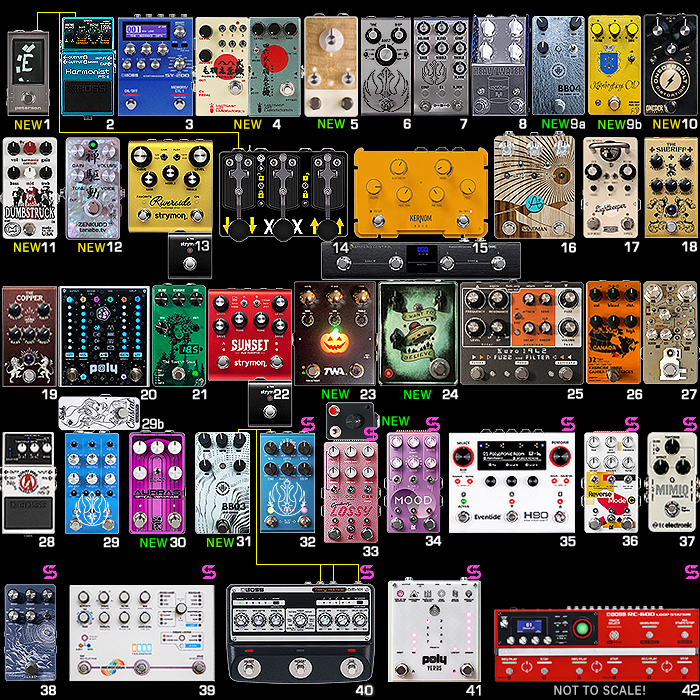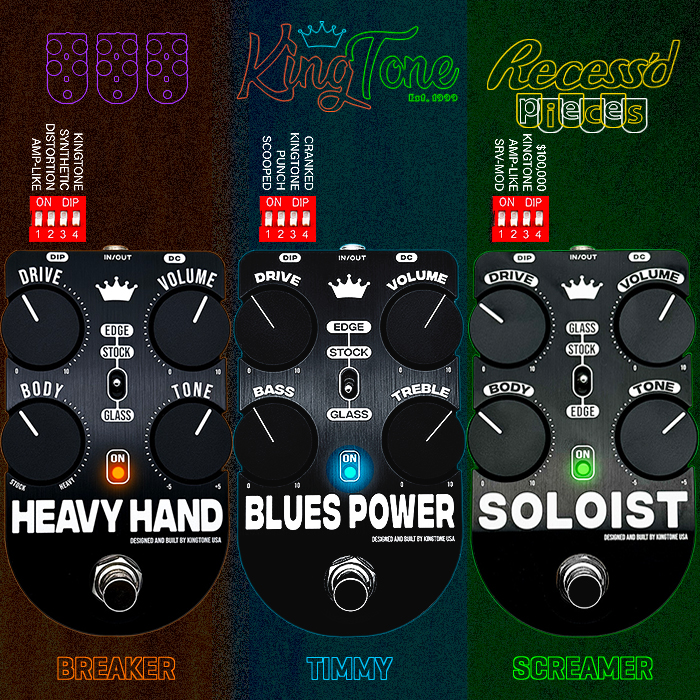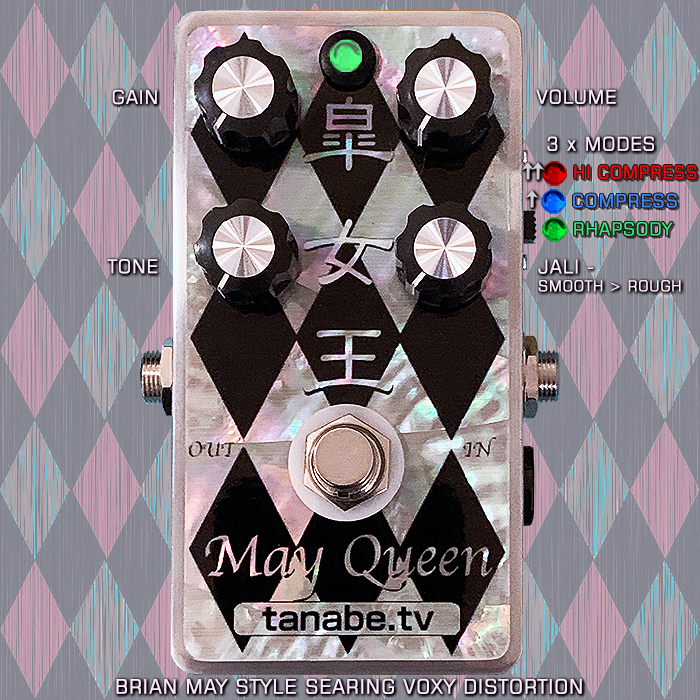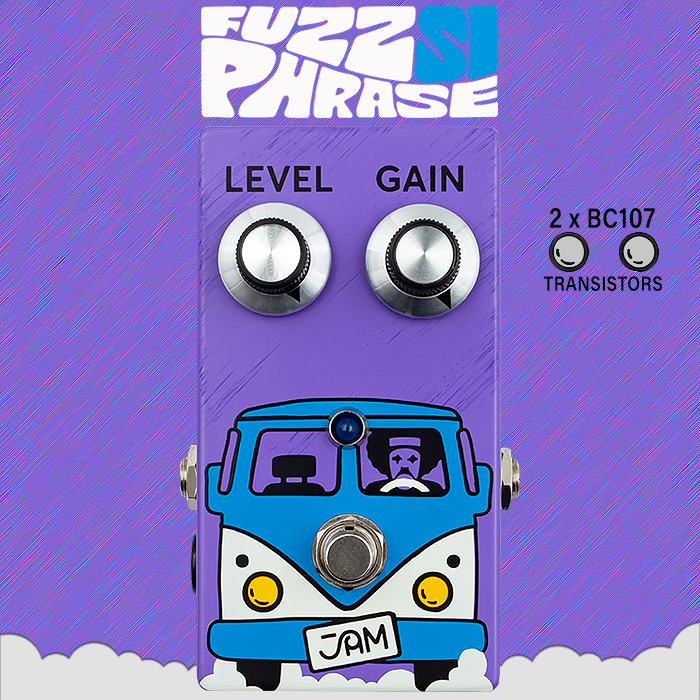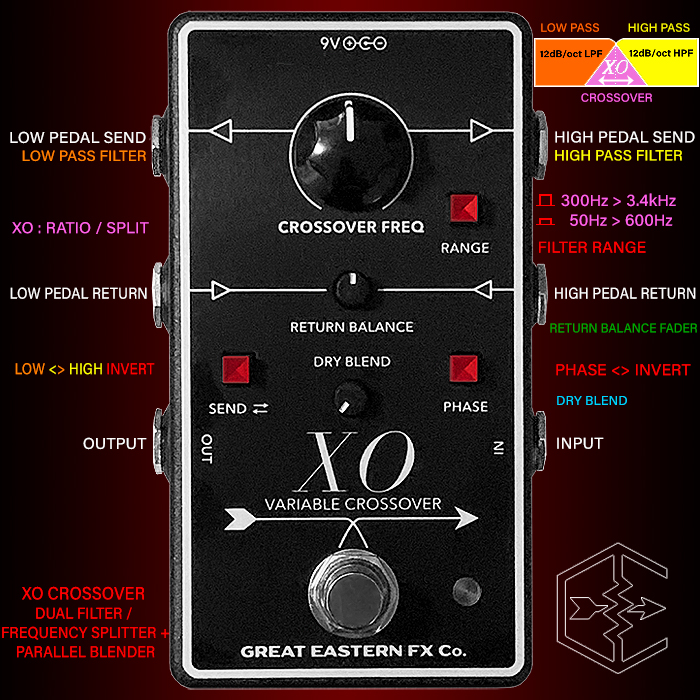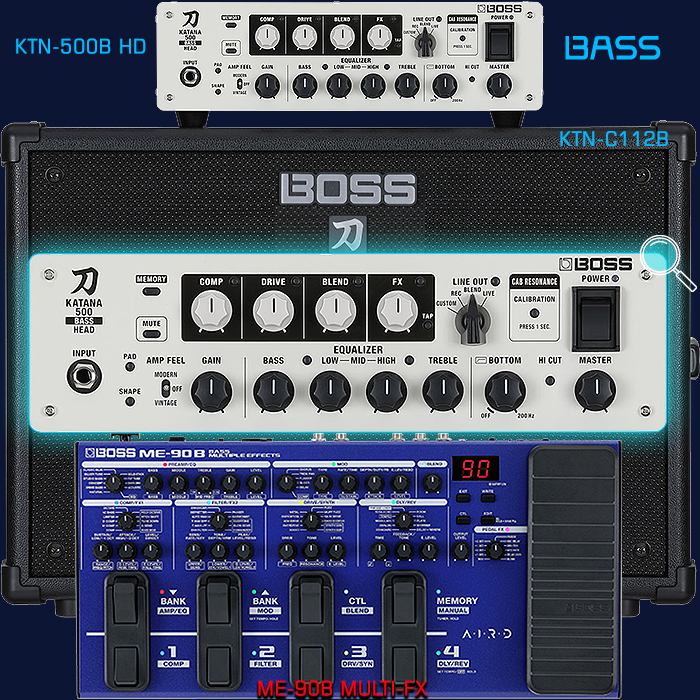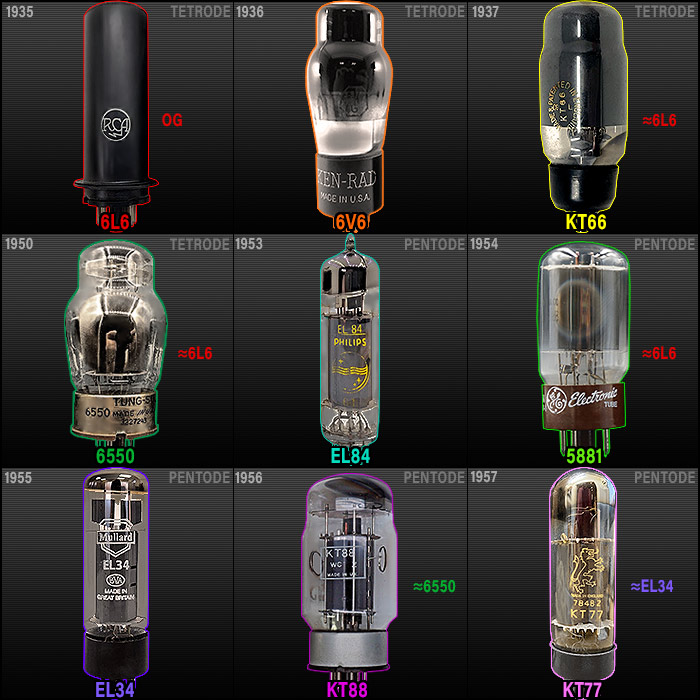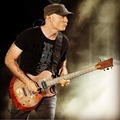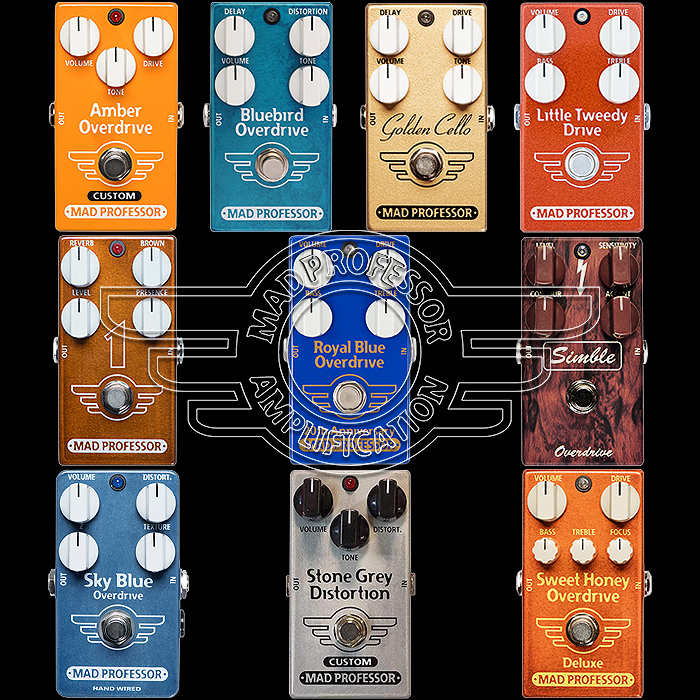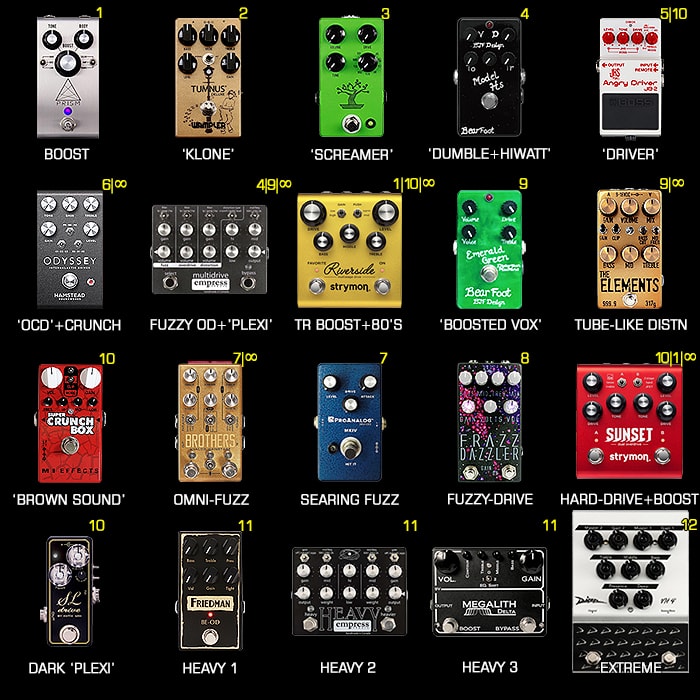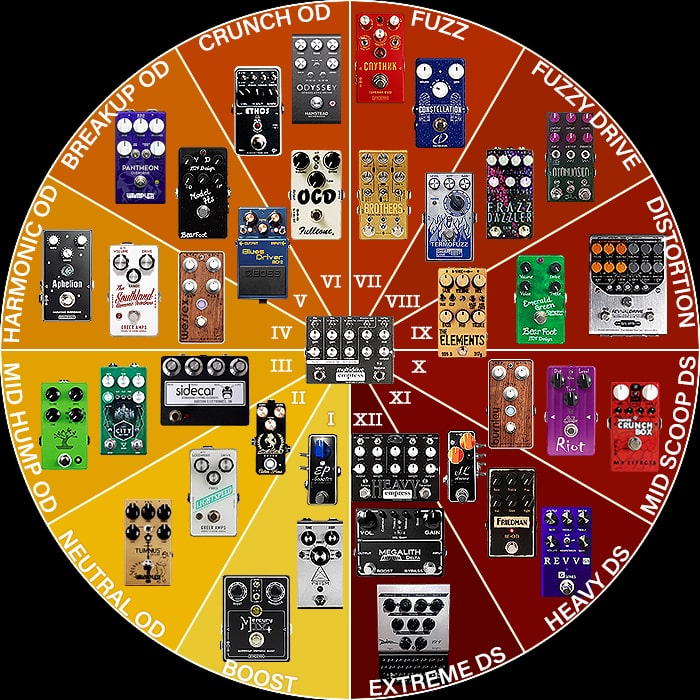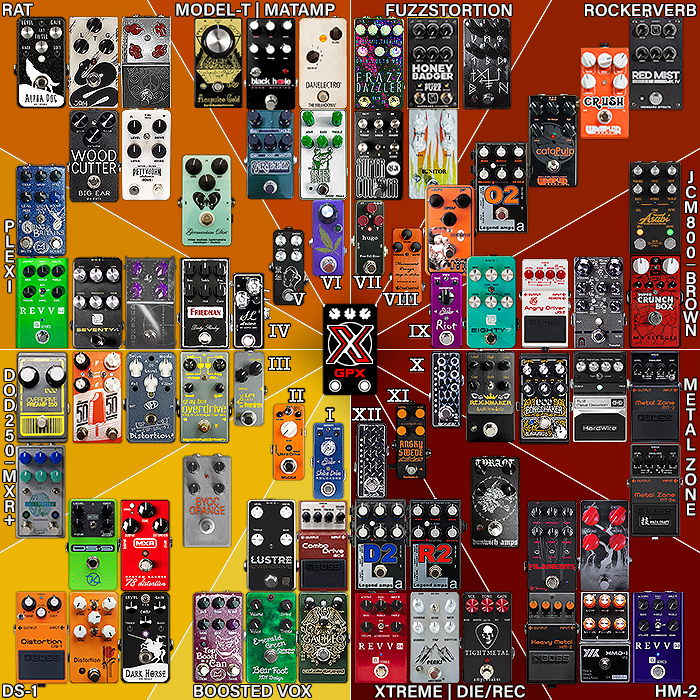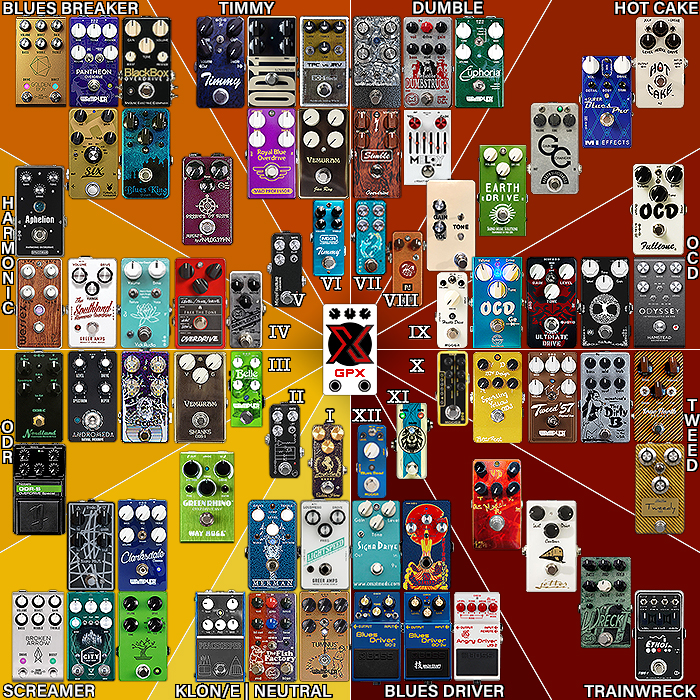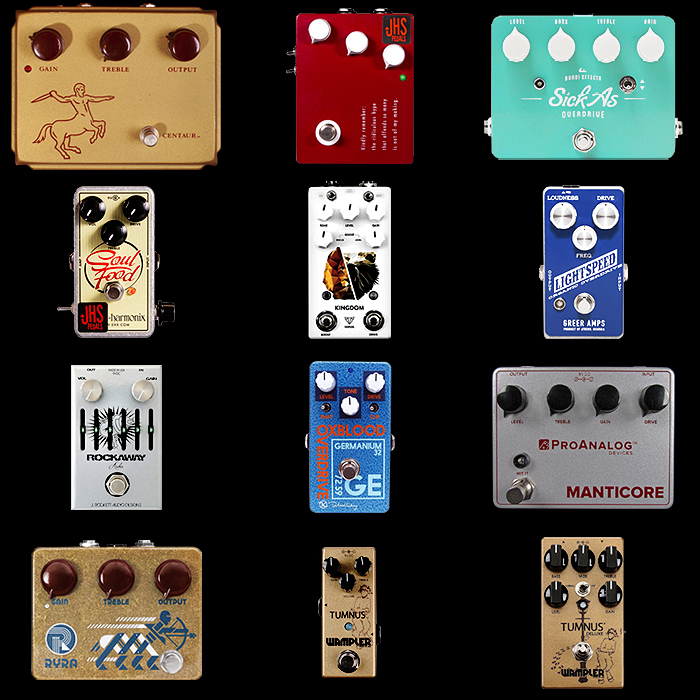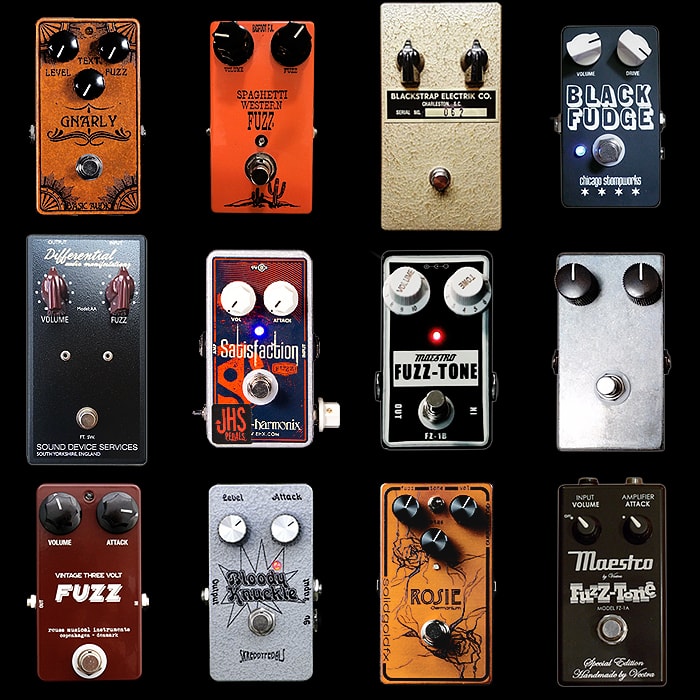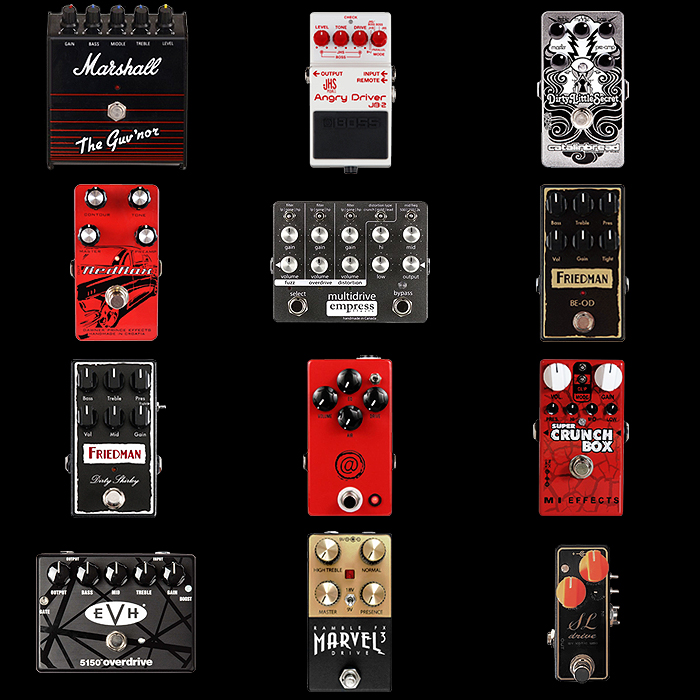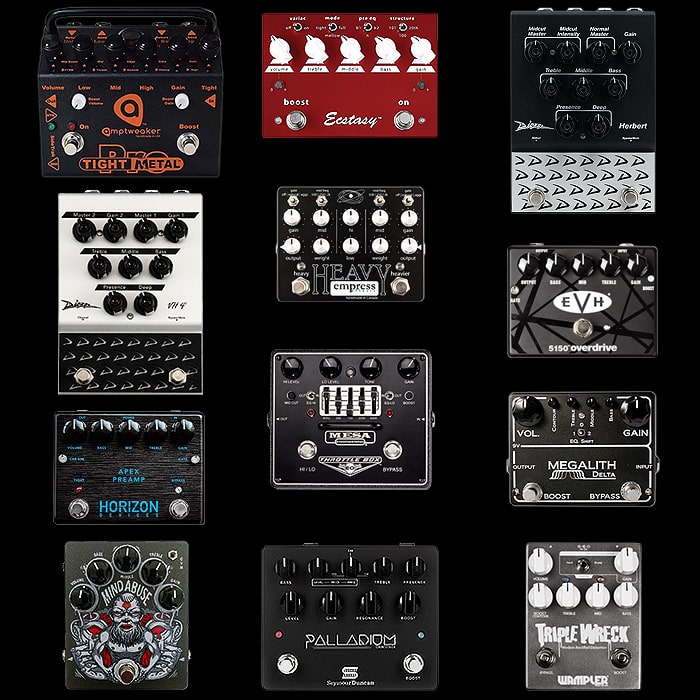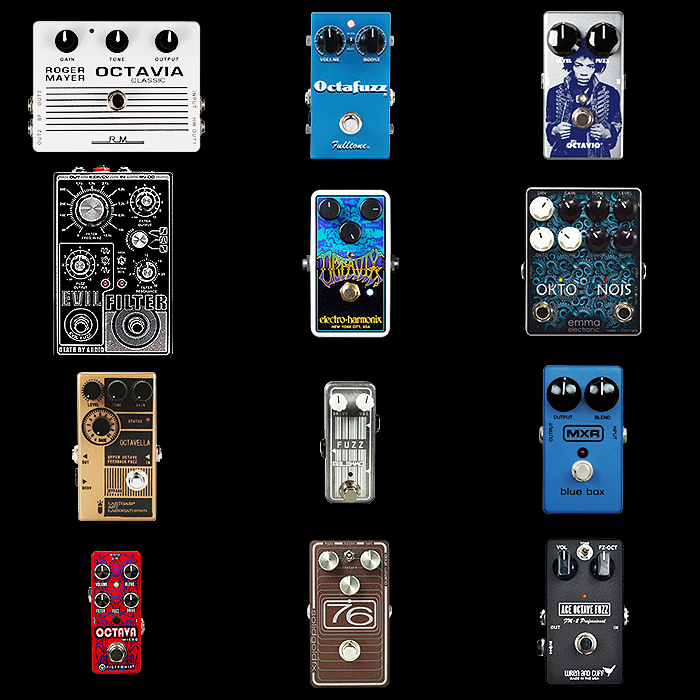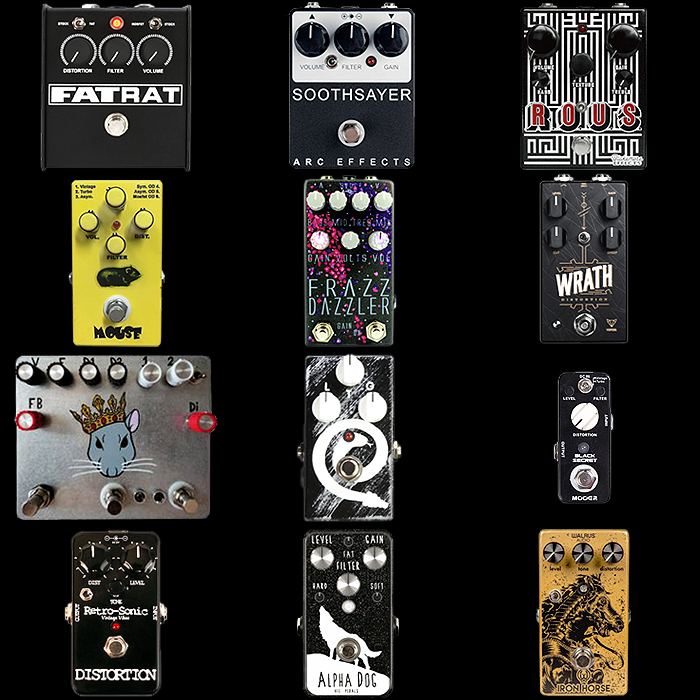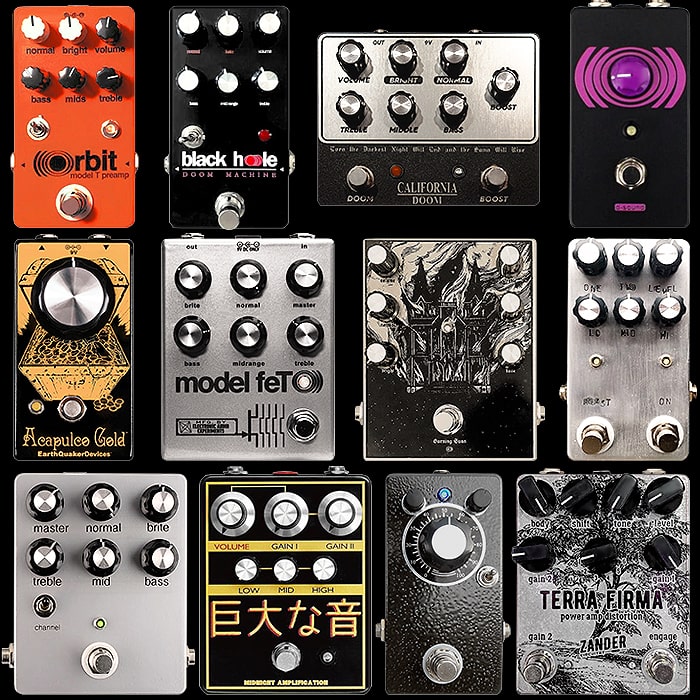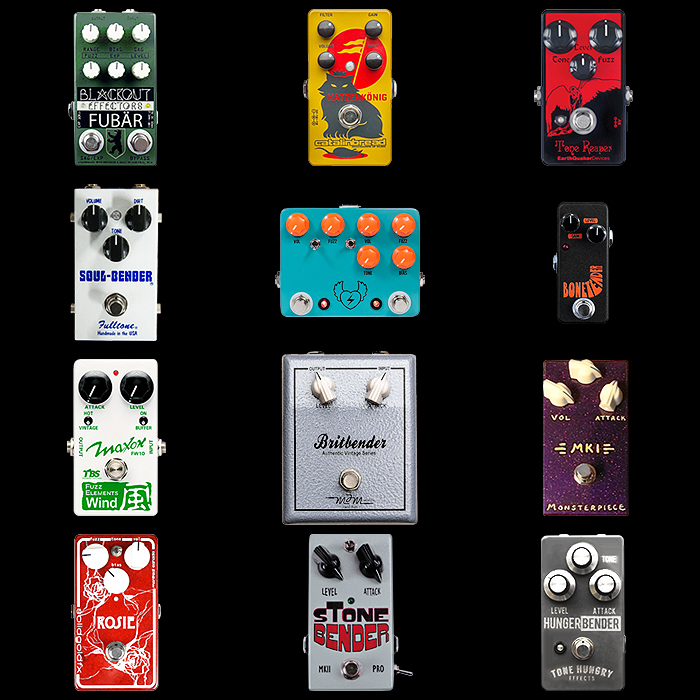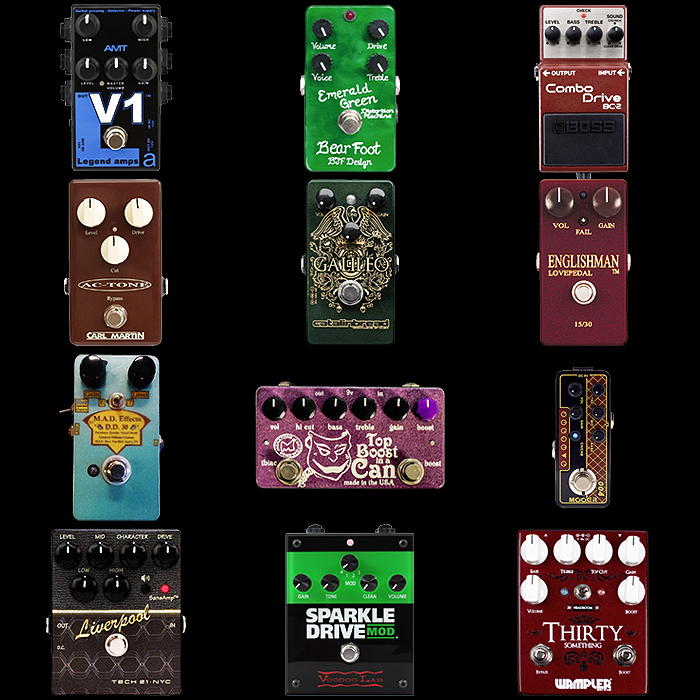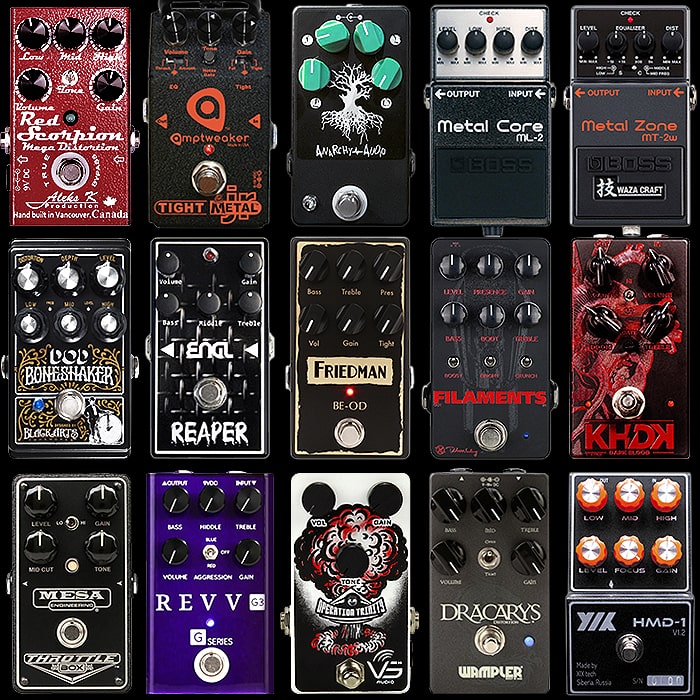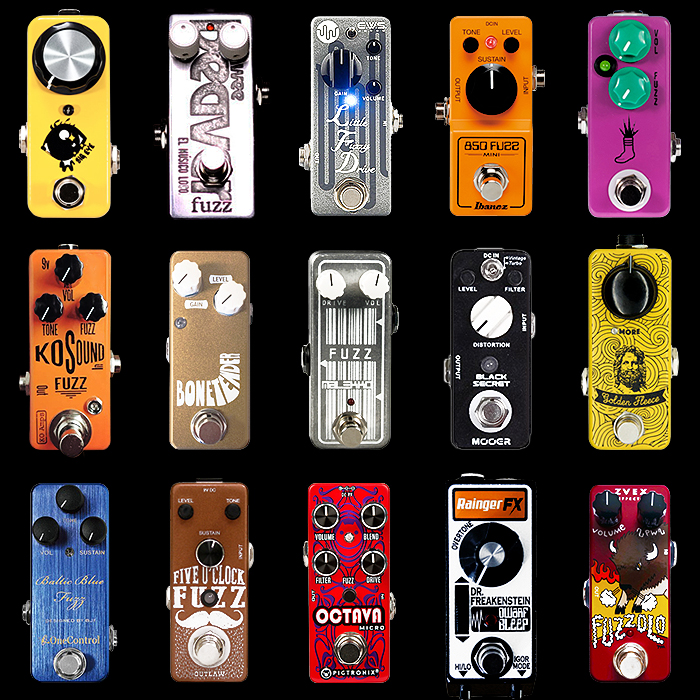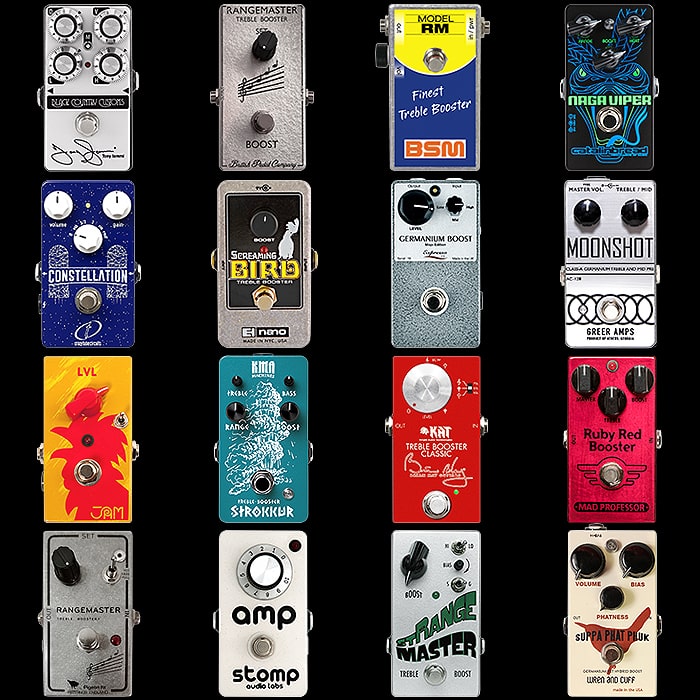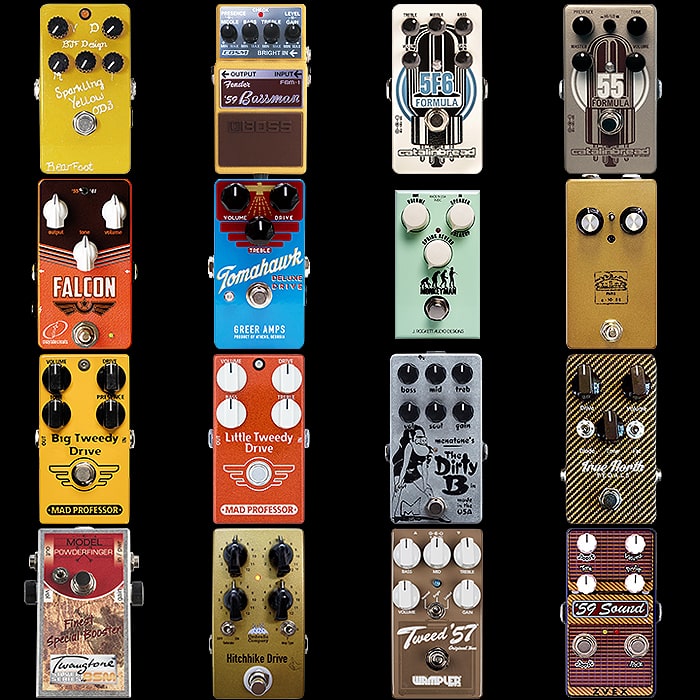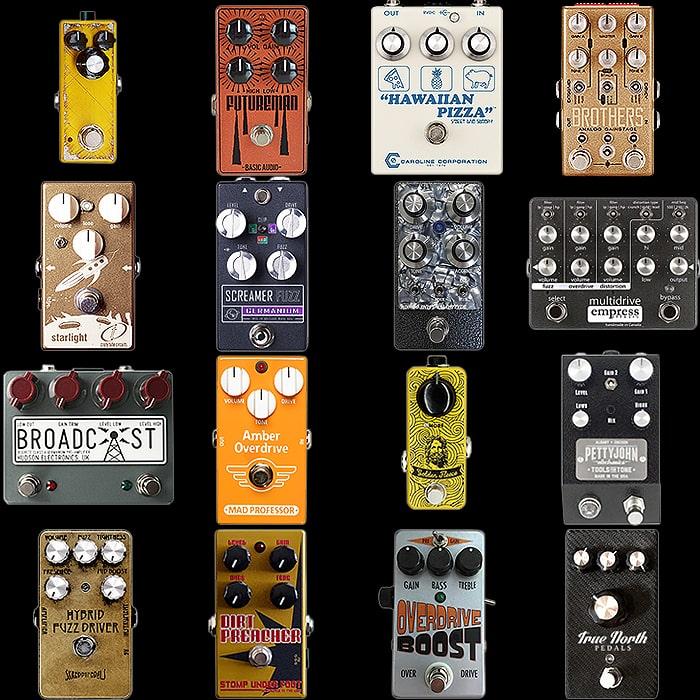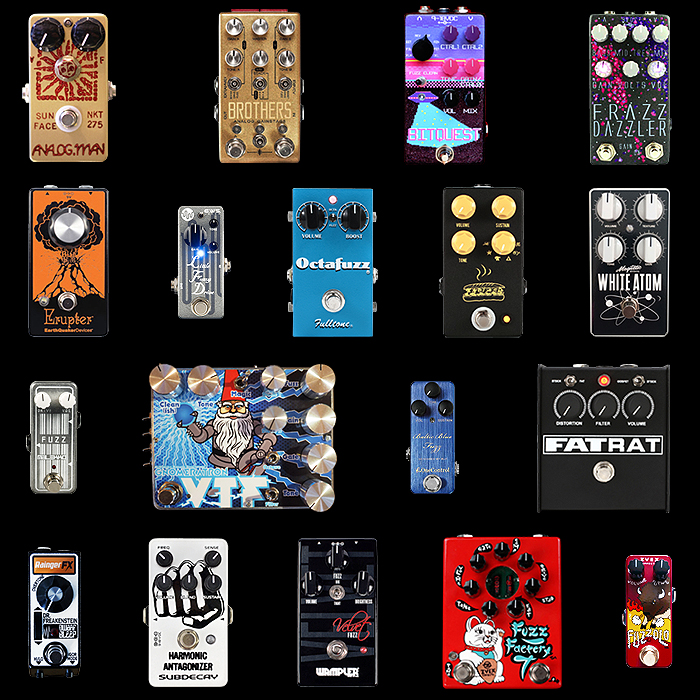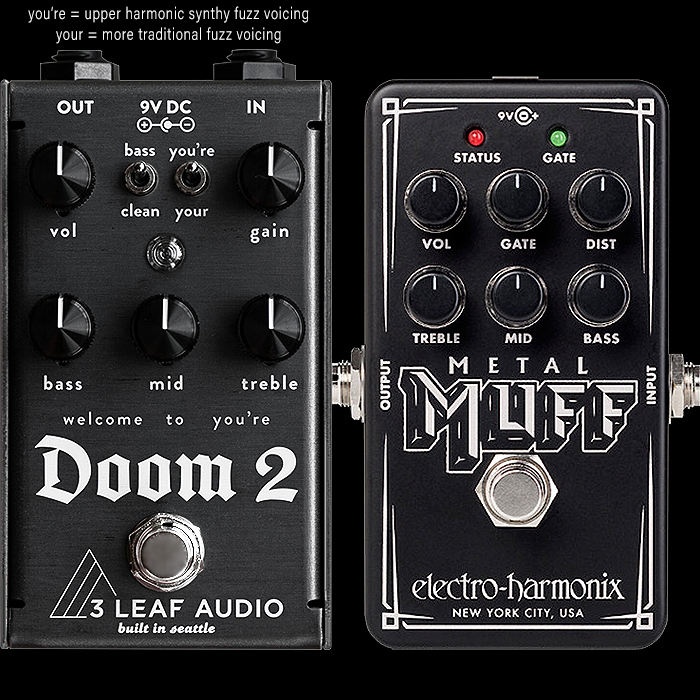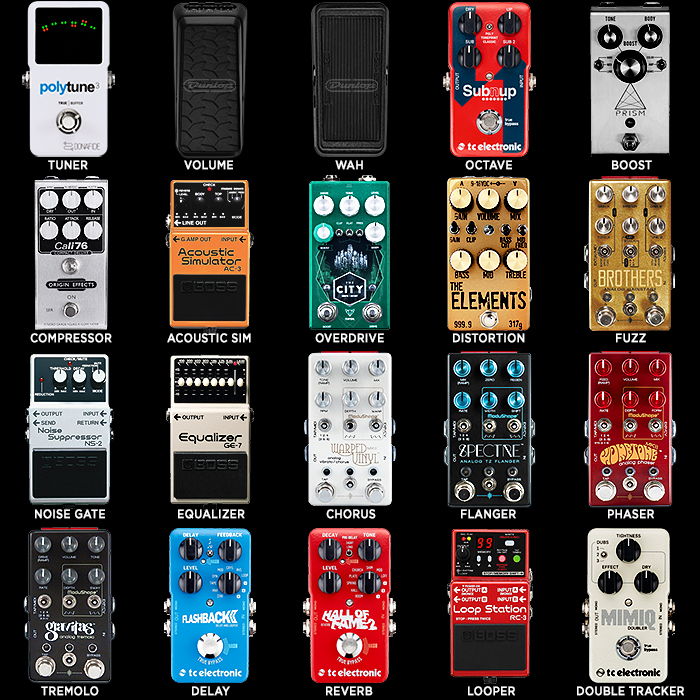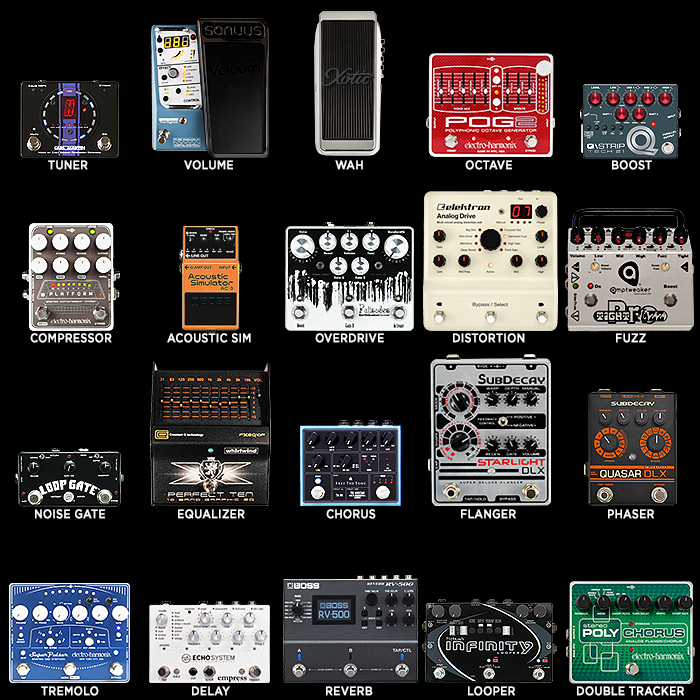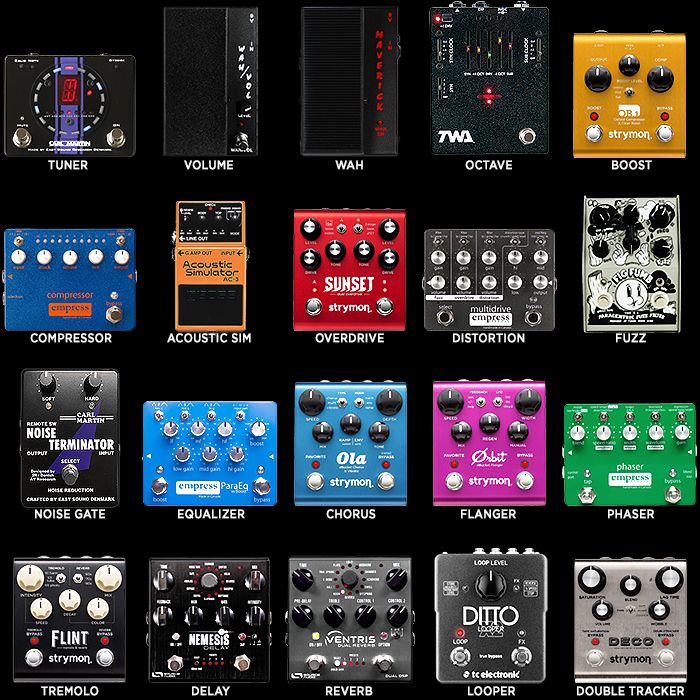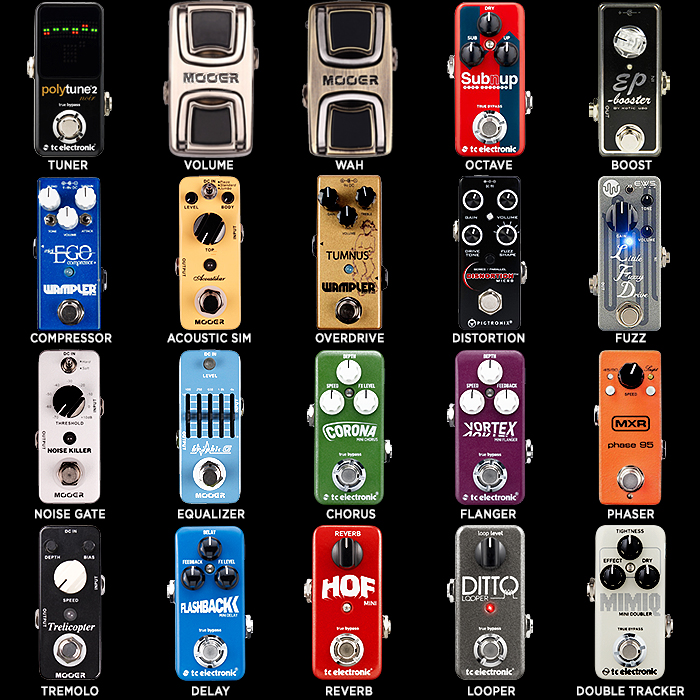12 Degrees of Saturation - Key Guitar Overdrive, Fuzz and Distortion Sounds
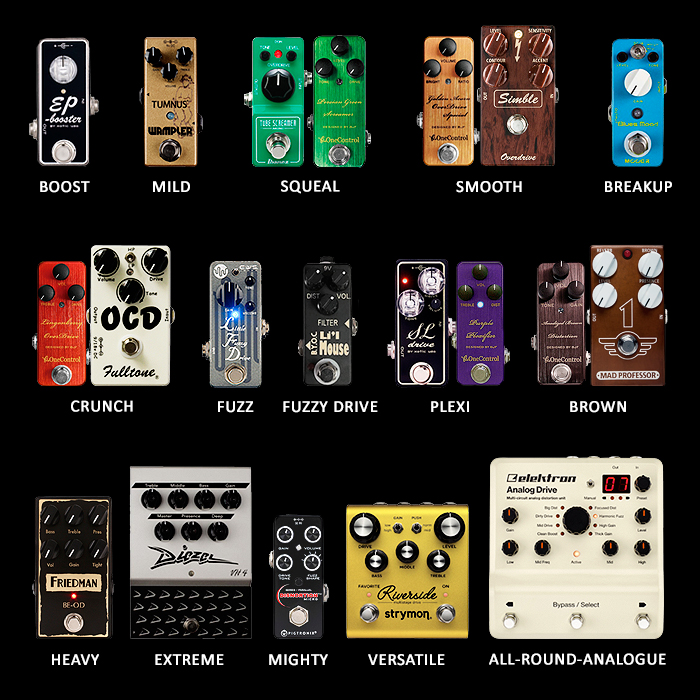
Note - New and Revised Article - [Here]
So another chapter of the Tone Quest is nearing its momentary end-point. In the ongoing efforts to arrive at the perfect Tone, I’ve been spending an inordinate amount of time experimenting with and researching overdrives, fuzzes and distortions. Being somewhat eclectic in my tastes, there are a number of the deemed key / core sounds I like. Some players sit squarely within ’Blues’, ’Rock’ or ’Metal’ or just one or two main niches as such - while I like bits of most everything. When I say most everything it does not necessarily include absolutely every sub-genre, and I still like a high degree of musicality to accompany the overall Tone - however noisy and distorted it gets.
As is ever the case, this is a balancing act between analogue and digital, passive and active circuits, hand-wired and PCB, and tubes versus electronics in some instances. Overdrives and distortions make use of very specific component transistors (silicon vs germanium, jfet vs mosfet etc.), capacitors, diodes and op amps / core processors / chips - each of which gives you a particular nuance, timbre and texture.
For instance, the fairly recent Strymon Riverside pedal has a mix of analogue and digital processing through four cascading gain stages - starting with analogue JFET transistors before progressing through several stages of digital processing. The strength of this pedal is that you get a high degree of clarity / tightness right along the scale of distortion. However, this means you don’t get the the really gritty / noisy distortion textures that typify certain heavier styles of music. The Fulltone OCD pedal by contrast has a fantastic fuzzy / dirty analogue texture which the Strymon Riverside cannot really fully replicate as its core configuration always leans somewhat towards clarity and audible separation of individual notes. You could say that the pedal is just a tiny touch too clean in some senses.
In the above visual, the pedals are not entirely to scale, as the difference between the small mini pedals and the enormous Elektron Analog Drive would be too extreme - so I have tried to rationalise the various pedals within context to give a key indication of rough size - the pedals are ordered here from lightest to heaviest gain, with a trio of versatile / all-rounder pedals at the end.
All of this needs to be taken with a certain pinch of salt, as readers / listeners / players will have likely different ’ears’, different preferences and thus come to quite diverse conclusions. I have tried to reference most of the best known overdrive and distortion pedal types / core sounds, but there will be various degrees of overlap, as well as some pedals which don’t sit entirely comfortably within select categories. The below list goes from the lightest touch of boost-like gain to extreme distortion, from unique, singular sounding pedals to highly versatile distortion workstations as such.
An important consideration is that several of these pedals could be assigned to different categories with different tones / levels of gain dialled in, and while some have a huge range of soundscapes, others are more fixed within a type or have very specific timbres which make them instantly audibly identifiable / stand out within a very specific context.
There are some pedals that I could not fit within a specific category, but which I wanted to mention anyway - that is to say actual tube-driven (mostly 12ax7-based) amp-like pedals such as the BK Butler Tube Driver, Dean Markley Overlord (Modded) and Effektrode Blackbird. If you had to buy just one pedal that did near enough everything, you would likely go for something like the relatively new Elektron Analog Drive - with its 8 independent wholly analogue circuits. Yet even this will have subtle variations when trying to dial in a particular known tone - based on specific component selection, circuit variations and specific configuration and deployment.
A great example of all of this is the ’Klon’ clone-type pedals, of which there are probably a 100 different examples in all shapes and sizes, official, unofficial, modded and DIY kits. My preferred Klon clone is the Wampler Tumnus - which adds in some delightful bottom end vs the original inspiration. It carries largely the same kind of flavour, but provides a slightly thicker, bassier tone which I love, but which several purists might dislike for similar opposing reasons.
To my ears often the sound-alikes or clones offer improvements over the originals, sometimes the copies really are nigh on identical - using the exact same core circuit/s and components and rendering the same essential solution, often in a smaller package or with some additional option switches / dip switches added. If you want a complex textured dirty sounding pedal, by its very nature it would need to be wholly or mostly analogue, the benefit of digital is uniformity and clarity of tone right throughout the different volume and gain stages.
Like I said earlier, the best current all-rounder out on release is the Elektron, but you cannot really use the Elektron properly unless you have had an education in dialing in and playing all those various different tone stages that the Elektron commands. The advantage of the Elektron is that you can easily dial in tones and save 100 presets to quickly switch between your chosen tones. There’s an entirely other kind of delight in stomping on each of those separate boxes to ramp up or smooth out your playing tone. I would also say that the Elektron does not get quite as heavy as the Friedman BE-OD and not close to the Extreme punchy distortion of the the Diezel. So as far as I am concerned, there is still no one overall pedal that can do absolutely everything!
Note that the following list, although expansive, is far from exhaustive, and still only just a part of what is available - and you will most likely disagree with some / several of my choices. I run the pedals into dual amps - a digital Boss Katana-100 and an all-tube Carvin VM3C via Radial Twin City ABY. And these choices are what work for my ears and my particular settings and setup.
In all cases you need to be patient and need to experiment when attempting to dial in the best possible tone. All pedals don’t necessarily suit all amps, some are more susceptible to deviation. A case in point is the Diezel VH4 pedal which many loath with a passion, but comes out great for me run directly into the amps (rather than via fx loop). In fact all my overdrive and distortion pedals run into the front of the amps, through Alchemy Audio modded Boss NS-2 Noise Gate and modded Boss GE-7 Equalizer - with Strymon Modulation and FX added at the end of the chain.
1 : BOOST
Boost can be used in a variety of ways - often wholly transparent simply volume boost by a few decibels (up to +20 or more), but there are various flavours here - you can boost treble, mids or lows, or even add just the tiniest touch of gain. Many boosters by default colour the signal a little - adding a little touch of warmth and/or compression. I have my Xotic EP Booster on permanently to add a little warmth and extra dynamism and headroom into the signal path. I use the Strymon Riverside for my actual lightest level ’Boost’ gain stage - the lightest of barely there gains with just a little added colour via the tone controls.
Pretty much everyone seems to make a boost pedal or two - here are some highlights, notables in bold:
SMALL - AnalogMan Beano Boost, Foxpedal Ebenezer Clean MOSFET Boost, Hotone LIFTUP Clean Boost , JHS Mini Bomb, JHS Pedals The Prestige Booster, Keeley Mini Katana Boost, Mooer Pure Boost, TC Electronic Spark Mini Booster, Tone City All Spark Boost, T Rex Karma Boost, Wampler dB+, Xotic EP Booster
REGULAR - Alexander Pedals Litho Boost, Blackstar LT Boost, Bogner Harlow Boost & Bloom , Boss FA-1, Catalinbread Naga Viper Treble Boost Pedal, Diamond Marquis Treble Boost, DOD Bi-Fet Boost, Dunlop EP101 Echoplex Preamp, Duesenberg DPE-GB Gold Boost , EarthQuaker Devices Arrows Boost, Electro-Harmonix LPB-1 Booster, Electro Harmonix Screaming Bird Treble Booster Nano, Fire Custom Shop Ariete Booster Pedal, Fire Custom Shop Power Booster, Free The Tone Custom Series FB-2 Final Booster, Fulltone 2B Booster, Greer Amps Pork N Beans Boost, Greer Amps Special Request, Hudson Gospel Bomb Boost , Ibanez BB9 Bottom Booster , Jack Orman MOSFET Booster, Jackson Audio Prism Buffer, J Rockett Audio Designs Lenny Color Boost, Mad Professor Ruby Red Booster, Maxon DB-10 Dual Booster , Maxon TBO-9 True Tube Booster/Overdrive, Mesa Boogie Tone Burst Boost , ModTone Signal Booster, Moog Minifooger Boost, MXR Boost / Line Driver, MXR Micro Amp/+, Oddfellow FX Napoleon Boost, Pharaoh Amplifiers Class-A Boost, Pigtronix Class A Boost, Providence FBT-1 Final Booster, Robert Keeley Katana Boost, Rothwell Atomic Booster, Rothwell F1 Booster, Seymour Duncan Pickup Booster, SolidgoldFX Nitro, Suhr Dual Boost, Suhr Iso Boost, Supro Boost, TC Electronic Rush Booster, TC Electronic Spark Booster, T-Rex Fat Shuga, Wampler Decibel Plus Buffer Boost, Wren and Cuff Phat Phuk, Xotic AC Booster / AC Plus, Xotic RC Booster
LARGE - Amptweaker PressuRizer Compressor & Boost, ARC Effects Gamut, Bigfoot Engineering Trouble Booster, Crazy Tube Circuits Vyagra Boost, Diamond Boost EQ, Emma Electronic OnoMATOpoeia clean boost, Empress Effects Buffer+ Stereo, Orange Two Stroke Boost EQ , Strymon OB1 Clean Boost Compressor, ThorpyFX The Peacekeeper, T Jauernig Electronics Luxury Drive - Clean Boost, Way Huge Angry Troll Linear Boost, Zvex Super Hard-On
2 : MILD OVERDRIVE (≈ Klon Centaur pedal)
Most of the Klon remakes / clones are still fairly sizeable boxes. If possible, I like to go as compact as is practical, and here Wampler’s Tumnus really produces the goods for me. Colouring the essential Klon tone with some added low-end yet in a subtle and understated fashion - retaining the same essential feel.
The Movall Minotaur / Tone City Bad Horse are other supposedly great small alternatives, lots of people favour the affordable Elektro-Harmonix Soul Food, which I also have in original and JHS modded varieties. There is an official remake in the form of the Klon KTR Centaur, while many also lean towards the faithful J Rockett Archer / Ikon reproductions.
Full selection with notables in bold:
SMALL - Movall Minotaur, Often FX Meta Driver, One Control Cranberry OverDrive, Tone City Bad Horse, Wampler Tumnus
REGULAR - Boo Instruments Klone KC, Electro-Harmonix Soul Food, JHS Klone, J Rockett Archer / Ikon / Silver / Gold, Matthews Effects The Architect, Rawkworks Light OD
LARGE - Anasounds Savage, ARC Effects Klone V2, Fredric Effects King of Klone, General Guitar Gadgets Klondike Overdrive, Kingsley Jester, Klon Klone, Klon KTR Centaur, Monsterpiece Stud, Pedal Monsters Klone, Rock Your Repaired Amp (RYRA) Klone, Tone Bakery Creme Brulee
3 : SQUEAL / BOOSTED MIDS OVERDRIVE (≈ Ibanez Tube Screamer pedal TS8 / TS9 / TS10)
The world’s most famous green pedal, which boosts the midrange frequencies to give you that satisfying guitar squeal or ’Tube Scream’ as it’s now most commonly known. This pedal is heavily replicated in all manner of varieties, the Ibanez Mini Tube Screamer is perfectly acceptable with its TS9 tones, although not too high output, one better in many ways is the Keeley Red Dirt Mini which came out of all the Keeley Tube Screamer Mods - here with 4 different dip-switch modes. Best for me though is the One Control Persian Green Screamer which has a switch for TS808 Vintage Mode, as well as TS9 modern.
The Mini Tube Screamer is very close to the full size TS9 tone, although I readily agree that the best overall sounding Tube Screamer is the 808 variety in either its regular format or extended Deluxe / DX version. The One Control Persian Green sort of gives you the best of both worlds here. We must not forget either that Maxon developed the Tube Screamer (808) sound for Ibanez before those two companies went their separate way.
Full selection with notables in bold:
SMALL - ENO OD-9, Ibanez Tube Screamer Mini, Keeley Red Dirt Mini, Mooer Green Mile, Mosky Tube Screamer, One Control Persian Green Screamer, Rowin Greenizer / Tube Drive, Tone City Kaffir Lime
REGULAR - Boss SD-1, Dazatronyx TSX, DigiTech Bad Monkey, Ibanez Tube Screamer TS808 / TS9, Kartakou Warmer Tube Screamer, JHS 808 Overdrive, Keisman Pedals Velvet Drive, Lell TSPS-700 Tube Screamer, Maxon OD-808, Nobels ODR-1, Seymour Duncan 805 Overdrive, TC Electronic Cinders
LARGE - Dr J Effects Green Crystal, EarthQuaker Devices Palisades, Ibanez Tube Screamer TS808DX, Way Huge Green Rhino
4 : SMOOTH ORGANIC OVERDRIVE (≈ Dumble Overdrive Special amp)
This is one of the categories that is most likely to be up for debate. The legendary Dumble Overdrive Special Amp of which only 300 or so were made, and currently cost between $70,000 and $100,000 to acquire second hand. The key tone here though is a smooth, mild, highly transparent light-touch overdrive with just a tiny hint of warm fuzz.
There are all manner of solutions available here, not one of which will exactly replicate the full frequency range of the amp’s sound, but most of which will get you right in the ballpark. The Hermida / LovePedal Zendrive is possibly the most well known, and if you have the money and space, you could go for a Custom Tones Ethos Overdrive or Van Weelden Royal Overdrive. For my money and ears, I prefer a more compact enclosure in this instance - Zendrive is nicely neutral, and the J Rockett The Dude and Mad Professor’s Simble each add their own flavours. The Simble for me wins out with its slightly fatter, bassier touch, it took a while for me to decide between The Dude and the Simble.
In the smallest form factor, the soon-to-be-released in Europe - One Control Golden Acorn OverDrive Special seems to do an amazing job of approximating some of the key Dumble tones too. Once it is out I will do a head-to-head with the Simble to see which one stays in the chain. I’ve tried OCD alternatives, but the full-regular-size OCD still holds its place. My chain is very long, so if I can find a worthy champion at the smaller size I usually go for it.
Here is the full selection with notables in bold:
SMALL - Aroma Tomsline Dumbler, HoTone Skyline Series Grass, Mooer Rumble Drive, One Control Golden Acorn OverDrive Special, Rowin Dumbler, Tone City Sweet Cream
REGULAR - Barber Small Fry, Gaspedals DumbBell, Jetter Gear GS 124, JHS Moonshine, J Rockett The Dude, LovePedal Hermida Audio Zendrive (Original / Black / Red / Gold), Mad Professor Simble, Providence Stampede OD, Mojo Hand FX DMBL, MXR Shin-Juku Drive, Shin’s Music Dumbloid, SubDecay Liquid Sunshine. Tanabe Dumkudo / Zenkudo, Wampler Euphoria
LARGE - Amplified Nation Big Bloom, CKK Lunar Drive Vintage, Custom Tones Ethos Overdrive, Fuchs Plush Drive / Valve Job, Mad Professor Twimble, Van Weelden Royal OVerdrive, Weehbo Dumbledore, Wilson Effects Dual Lotus Drive II
5: MEDIUM BREAKUP OVERDRIVE (≈ AnalogMan King of Tone / Boss BD-2 Blues Driver pedals)
This started purely as a Blues Driver reference, but I wanted to somehow bring King of Tone into the picture, and thought that this might be the most suitable category. This overdrive sits just under the Crunch in terms of punch, and has indeed a more bluesy buzz about it. Of course you can dial in more punch here, but you don’t have quite the same degree of attack and noise as does the Fulltone OCD.
The Chinese-made mini pedals are usually most appealing because of their low cost, then compact size, and usually thirdly a close-ish approximation of tone. In this instance, the Mooer Blues Mood hits the triple threat with a really fantastic replication of a Keeley-modified Boss Blues Driver. So a clever twist on the original in a more compact form factor and with two-way toggle voice selector. The AnalogMan King of Tone is capable of similar tones and much more, its footprint and cost though is more than 10 times that of the diminutive Mooer, which is my pedal of choice here.
Full selection with notables in bold:
SMALL - AMT B-Drive, HoTone Skyline Series Blues, Mooer Blues Mood
REGULAR - Boss BD-2 / W Blues Driver, DigiTech Screamin’ Blues, Keeley Katana Blues Drive, Pedaltank Blue Overdrive, VFE Pedals Blues King, Wampler Paisley Drive
LARGE - AnalogMan King of Tone, , Fulltone Full-Drive 3, J Rockett Tim Pierce Signature, Lazy J Cruiser Deuce , LovePedal Amp Eleven, Tone City King of Blues, T-Rex Møller 2, Wampler Dual Fusion
6 : CRUNCH OVERDRIVE (≈ Fulltone OCD pedal)
A wonderfully texturally complex distortion tone. The OCD has amazing distortion harmonics, but manages to stay just on the right side of musical and controllable. It’s a very distinctive tone that is very obviously analogue sounding. Digital pedals have a hard time replicating this pedal exactly as they are intrinsically prone to smoothing and clarifying output.
By all accounts the Mooer Hustle Drive is a reasonably copy, but here I side with the original OCD, currently in its 7th iteration (V 1.7). I also find that the One Control Lingonberry OverDrive is reasonably close, but with a slightly cleaner tone.
Full selection with notables in bold:
SMALL - ENO Trouble Overdrive, Joyo Husky Drive, LovePedal Bonetender, Mooer Hustle Drive, One Control Lingonberry OverDrive
REGULAR - Barber Direct Drive, Catalinbread Formula 5, EarthQuaker Devices Talons, Fulltone OCD, Joyo Ultimate Drive, Mad Professor Sweet Honey Overdrive, MI Audio Crunch Box, Mojo Hand FX Rook, Weehbo Bastard
LARGE - Mojo Hand FX Rook Royale, Zvex Box of Rock
7 : FUZZ (≈ Jimi Hendrix Fuzz Face pedal)
Very much part of the sound we now automatically associate with Jimi Hendrix - originally the Dallas Arbiter Fuzz Face, now faithfully reproduced by Dunlop in all its various guises. The other heavy hitter fuzz pedals are the Electro-Harmonix Big Muff (-Pi) and all-rounder fuzz workstation - the Zvex Fuzz Factory 7.
My choice here is an excellent mini Japanese pedal (sister company to Xotic) - the EWS Little Fuzzy Drive - this has two toggle option voicings - regular and fat - giving you a tremendous range of tones from such a small format.
Full selection with notables in bold:
SMALL - EWS Little Fuzzy Drive, One Control Baltic Blue Fuzz, Rainger FX Dr. Freakenstein’s Dwarf Bleep, Zvex Fuzzolo
REGULAR - Dr. Scientist BitQuest, Dr. Scientist Frazz Dazzler, Dunlop Fuzz Face Mini Hendrix, EarthQuaker Devices Fuzz Master General, Fulltone 70-BC Fuzz, Keeley Electronics Psi Fuzz, Menatone The PoPo Fuzz, Old Blood Noise Endeavors Haunt Fuzz, SolidGoldFX If 6 Was 9 BC183CC
LARGE - Dunlop Jimi Hendrix Fuzz Face, Dwarfcraft Devices Necromancer, Dwarfcraft Devices Silver Rose V2, EarthQuaker Devices Hoof Reaper Octave Fuzz , EarthQuaker Devices Spires, Electro-Harmonix Deluxe Big Muff Pi, El Rey Effects Mystic Ouija Fuzz, Keeley Electronics Monterey Rotary Fuzz Vibe, Red Witch Fuzz God II, ScreaminFX 1954 Fuzz, SolidGoldFX Formula 76, Voodoo Lab Superfuzz, Walrus Audio Janus, Way Huge Swollen Pickle Jumbo Fuzz, Zvex Fat Fuzz Factory, Zvex Fuzz Factory 7
8: FUZZ DISTORTION (≈ ProCo Rat pedal)
Another unique pedal which combines a kind of rough and dirty OCD-style overdrive/distortion with a healthy dose of fuzz. The main native variations of original ProCo Rat have overly large enclosures/cases for my liking, so I’ve gone for a smaller form factor - a DIY Kit BYOC Li’l Mouse, assembled and polished up by Johnny Balmer of Alchemy Audio. This mini pedal uses the same core circuit and components of the original forebear within a much more convenient footprint. The Mooer Black Secret is really good too and gives you an additional Turbo voicing via 2-way toggle, as the standard Rat is not particularly high output. I tend to alternate use between the Li’l Mouse and the Black Secret.
If you have space on your board you may as well go for one of the many varieties of ProCo Rat now available, and if you are adventurous, you can try out the new Chase Bliss Brothers Analog Gainstage which does some very interesting things with fuzz distortion.
Full selection with notables in bold:
SMALL - BYOC Li’l Mouse, ENO Myomorpha, Mooer Black Secret
REGULAR - Chase Bliss Brothers Analog Gainstage, Cmatmods Ratified, Freakshow FX Brown Rabbit, JAM Pedals Rattler, Red Witch Ivy, VFE Alpha Dog
LARGE - Black Arts Toneworks Pharaoh Supreme, Beavis Audio FKR, Blakemore R.O.U.S, Death By Audio Apocalypse, Fuzzrocious Rat King, Little Bear R.attack, ProCo Rat/2
9 : PLEXI DISTORTION (≈ Marshall Plexi Stack)
Everyone loves the distorted Marshall Stack sound - full-bore distortion with some pronounced mid tones. Here again there are lots of usual suspects - the LovePedal Purple Plexi, Suhr Riot, Wampler Plexi-Drive and the very boutique LPD Sixty8 Drive. I have once more settled on a smaller pedal - using an Xotic SL Drive (Alchemy Audio modded) with voltage doubler for maximum 18V headroom. The One Control Purple Plexifier and Tone City Golden Plexi are two more great alternative mini pedals.
Full selection with notables in bold:
SMALL - Joyo Hot Plexi, Movall Plexi Troll, One Control Purple Plexifier, Rowin Plexion, Tone City Golden Plexi, Xotic Effects SL Drive
REGULAR - Caline CP-14 English Man Plexi, Carl Martin PlexiTone, Catalinbread Dirty Little Secret, Greer Amps Little Samson, JHS @, Lawrence Petross Design Sixty8 Drive, LovePedal Purple Plexi, Puzzlesounds Plexi Overdrive, Suhr Riot, Supro Drive, TC Electronic Dark Matter, Wampler Plexi-Drive
LARGE - Blackstar HT Drive, Bogner La Grange Plexi Overdrive, Pedal Monsters The Heisenberg Dual Drive, Radial Bones London Dual Distortion, Radial Tonebone Plexitube, Tech 21 Hot-Rod Plexi, Voodoo Lab Sparkle Drive Mod, Wampler Plexi-Drive Deluxe, Weehbo Plexdrive, Xotic Effects BB+
10 : BROWN SOUND DISTORTION / SCOOPED MIDS (≈ Eddie Van Halen’s Variac-modified Marshall 1959 amp)
This is the famous Eddie Van Halen sound of the 80’s - known variously as the EVH / 5150 and/or ’The Brown Sound’. It is essentially a high gain distortion sound with bass and treble dialled all the way up and mid tones dialled all the way down - AKA Scooped Mids.
There are a number of dedicated EVH pedals out there - like the signature MXR EVH 5150 Overdrive. The Wampler Pinnacle / Deluxe also does an excellent job replicating these sorts of tones, as does the outstanding Mad Professor 1 which blends in Plate Reverb too - to give you the complete EVH amp sound, you just need to add phaser for full-on gig-ready effect.
For me this is a tone that the Strymon Riverside does really well - giving it an added 80’s sheen through its digital processing. I have my Riverside set to two quite different gain stages - Brown on the favourite switch, and a very mild, smooth boost-like overdrive on the manual dials. The Riverside has a fairly smooth profile, it does do high gain distortion, but not with that really dirty grit that certain analogue pedals are so capable of. Hence, the Riverside is not quite the complete all-rounder it needs to be, but it does do certain things very well.
For a mini version of the Brown Sound the One Control Anodized Brown Distortion is kind of in the ballpark, but does not really have the necessary bass response.
Full selection with notables in bold:
SMALL - Joyo Little Blaster, One Control Anodized Brown Distortion
REGULAR - Boss ST-2 Power Stack, Cmatmods Brownie, DOD American Metal, General Guitar Gadgets BSIAB2, JHS Angry Charlie, MI Audio Super Crunch Box, Kaden Effects Brown Creeper, Mad Professor 1, MI Audio Super Crunch Box, Solid Gold FX Super Drive
LARGE - Amptweaker Tight Rock, MXR EVH 5150 Overdrive, Strymon Riverside, Wampler Pinnacle Deluxe
11: HEAVY DISTORTION (≈ MESA/Boogie Triple Rectifier amp)
Things can start to get a little contentious here, as there can be some significant crossover between what constitutes Hard / Heavy Rock and what relatively-high-gain Metal should sound like. For my own distinction, this category still has slightly ringing undertones (i.e. still a noticeable transfer of string vibration/jangle), even though definition is still quite tight. Heavier Modern Metal has a slightly more pronounced hint of compression, with the tightest note definition and almost a staccato percussive attack / edge.
My own ’Heavy’ pedal of choice is the excellent Friedman BE-OD with Volume and Gain at 2 o’clock and Bass and Tight settings on full. The AmpTweaker BigRock Pro also gets good reviews, as does the Decibel 11 Dirt Clod.
Full selection with notables in bold:
SMALL - EWS Little Brute Drive, Tone City Wild Fire
REGULAR - Boss DS-1X, Boss DS-2 Turbo Distortion, DOD Boneshaker, Fulltone Plimsoul, Keeley Stahlhammer Distortion, Malekko Wolftone Sloika, Mesa Boogie Throttle Box, MXR Distortion+, MXR Super Badass / Custom Badass ’78 Distortion
LARGE - Amptweaker BigRock Pro, Decibel 11 Dirt Clod, Friedman BE-OD, MESA/Boogie Throttle Box EQ, Seymour Duncan Dirty Deed, Wampler Sovereign, Weehbo Morbid Drive
12 : EXTREME DISTORTION / DJENT (≈ Diezel VH4 amp - Channels 3 & 4)
Proper Pounding Metal tones for me are the providence of the 3 German powerhouse amp manufacturers - Diezel, ENGL and Hughes & Kettner. I really love my Diezel VH4 pedal for this kind of compressed / processed filthy distorted sound. It requires careful dialling in, but contrary to many reports it can sound great in the front of the amp as well as of course into the power-amp / effects loop. I have the MK1 Channel 3 version which is barely a few months old - a new MKII Channel 3 + 4 version was introduced at NAMM and is imminent, I will of course upgrade immediately when this happens - it’s amazing to have such relatively low-cost access to the signature Diezel sound.
I’ve long considered the Wampler Triple Wreck and Amptweaker TightMetal Pro to be contenders here too. Specialists Goosoniqueworx and Okko also deserve a look-in / audition.
I’m not sure the mini pedals can quite compete with the full-bore headroom power and thickness of the larger ones here - I’ve still to encounter a small pedal that comes anywhere close to the Diezel. I’ve a mind to relegate all the mini pedals here down to the Heavy category. A lot of these are also missing the deep low-end oomph of the leading extreme pedals. If anyone knows of a mini pedal that can properly compete here - please let me know!
Full selection with notables in bold:
SMALL - Ibanez Super Metal Mini, Joyo Bullet Metal, Joyo Metal Head, Mooer Blade Metal, Stagg Blaxx Metal, Xvive Metal
REGULAR - Blackstar LT Metal, Boss ML-2 Metal Core, Boss MT-2 Metal Zone, DigiTech HardWire, Electro-Harmonix Nano Metal Muff, Ibanez MSL Metal Screamer, Keeley Filaments, Moen Medal Madness, Moen Violent Metal, MXR Fullbore Metal, Ogre Thunderclap, Wampler Dracarys
LARGE - Amptweaker FatMetal / Pro, Amptweaker TightMetal / Pro, Blackstar HT Metal, Bogner Uberschall, Diezel VH4, Electro-Harmonix Metal Muff, Emma Electronic PY-1 PisdiYAUwot, Empress Heavy, Engl Reaper, Engl Straight to Hell, Goosoniqueworx Seventheaven, Lone Wolf Audio Left Hand Wrath, Okko Dominator, Rivera Metal Shaman, Rocktron Metal Planet, Toneczar Openhaus, Wampler Triple Wreck, Weehbo Helldrive, Zvex Box of Metal
+ : ALL-ROUNDERS (≈ Good for nearly everything)
When I bought the Strymon Riverside I was hoping that this would be the solution to all my overdrive / distortion needs. As reported variously above though, it has its weaknesses as well as its strengths. The Elektron Analog Drive pedal by contrast is what the Riverside should have been - 8 separate analogue circuits which give you everything from the lightest clean boost tones, through fuzz overdrive, and onto genuinely thick metal-like distortion (but not quite BE-OD or Diezel level). As all the Elektron circuits are fully analogue we get lovely harmonic distortion artifacts here that digital pedals are wont to smooth out. The Elektron has great Tube Screamer and Klon voicings, as well as solid Marshall-esque and fuzz tones, but it does not really replicate the smokey Mooer Blues Mood, OCD or Rat-like distortions. What it does amazingly is have 100 programmable presets which allows you to switch between a vast range of tones, while the Riverside only has 2 (Manual & Favourite)(You could argue 4 - with the additional booster pedal attached, but these are variations of the 2 rather than wholly unique voicings / soundstages) - I’m still waiting for a better solution here - which can replicate more accurately each of my 12 stages of saturation. As it is my All-Round pedals kind of fill in in-between tones, but I often prefer simply stomping on the appropriate dedicated gain stage level pedal - which I know has my preferred sound bang on correct.
For pedals like the Analog Drive, without going through the above journey of the various individual pedals and their own unique voicings and gain stages, you could not really be n a clear position to dial in all the right tones yourself. All the below pedals are fantastic each in their own way, but even with everything the Elektron contains - it’s still not perfect. I’m kind of banking on Strymon doing a bigger brother to the Riverside - with added dials / controls for dirt / grit, tightness and fatness / thickness - so that you really can properly have all 12 gain stages in the one pedal.
As with everything, it right now seems a little too tricky for a single device (even with 8 spearate circuits) to give you absolutely all you need. Components and circuits can/may vary, and there may be some sounds that don’t quite match your expectations. The big downside with the Elektron Analog Drive is its enormous size - I thought the Diezel pedal was big, but the Elektron is simply gigantic. You are normally best with mixing and matching things up, and some pedals allow you to layer up different sounds (dual channel / stacking), while others don’t. The Source Audio LA Lady is particularly clever in that regard but is wholly digital. To my mind to get the correct balance you must use proper analogue circuits at the heart of the pedal - with all the appropriate and different analogue clipping types, and old-fashioned op amps that alone can provide those somewhat randomized and fully organic dirty distortions.
Special mention must be made of forthcoming Pigtronix Micro Disnortion pedal which seems to do a similar thing to the forthcoming much larger Emerson Pomerary - with 6 different analogue clipping stages and parallel or serial options for an incredible range of overdrive and distortion tones in a mini pedal - I will be acquiring that also when it reaches these shores (Update - acquired for $129 on eBay!).
Full selection with notables in bold:
SMALL - Pigtronix Micro Disnortion
REGULAR - Chase Bliss Brothers Analog Gainstage, Dr. Scientist The Elements, Source Audio LA Lady Overdrive
LARGE - Dr. Scientist Heisenberg Molecular Overdrive, Elektron Analog Drive, Emerson Custom Pomeray Dual Overdrive, Empress Multidrive, Positive Grid Bias Distortion, Seymour Duncan Palladium Gain Stage, Strymon Riverside
OBSERVATIONS AND NOTES
All effects pedals have had some significant R&D poured into them so you should show them and yourself the respect to persevere in trying to dial in the right tone. Some pedals are more forgiving than others and allow you to dial in amazing tones almost any which way. Other pedals have certain sweet spots which you need to find for your particular setup - guitar pickups and amps being of critical importance.
You will occasionally acquire a pedal that is allergic to your set up - no matter what you do, you are unable to dial in a satisfactory tone. You need to be mindful that the cheaper pedals are made with cheaper materials / components, and have less tolerances, less headroom, and typically a more opaque / muddy / thin soundstage. While the very best petals sound open and wide, deep and immense.
Pedals can be upgraded via modding - swapping out cheaper components for higher quality ones. This can often yield amazing results, but often the smaller form factor has inherent restrictions in what components can be used, laid-out and best optimised.
I do most of my ’research’ on YouTube and at home - I rarely try anything in store, as it takes me at least a week of living with it to know whether I am satisfied or not. I am rarely disappointed with a pedal purchase - I usually know what I’m in for if I’ve done my due diligence properly. Like I say above though, you will occasionally hit upon a pedal that just does not sit well within your setup - possibly has insufficient output volume or range to sit alongside those already in the chain.
After a while you get a handle for what your core setup baseline is, and what pedals are likely to work best - in terms of how they are voiced. The amazing thing about pedals is just how many are out there in the world. However many I reference on this page, it’s still just a drop in the ocean - there are hundreds of more varieties out there still waiting to be discovered. I actually have 14 overdrive / fuzz / distortion pedals in my chain at the moment which is extreme, but which is highly unlikely to ever increase. I am hoping to be able to switch out and consolidate going forward. If I could have all my gain stages in a single pedal I would leap at it, as long as I could wholly accurately reproduce my tones, be able to save them to presets and be able to easily and instantly switch between them, while keeping output volumes even and consistent! I already have a compressor near the start of the chain, possibly I will need to add one toward the end too, in order to further moderate and equalize the different gain stage outputs.
I see the trend at the moment generally splitting in two directions - small pedals which do one or two things brilliantly - i.e. more high quality boutique manufaturers introducing smaller versions of their best-sellers, as well as the evolution to larger workstations which cover all the fx you need within a particular category - be it modulation, delay, reverb or distortion ... much like the Elektron Analog Drive - but better!

